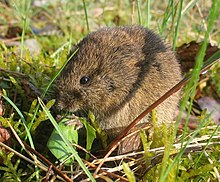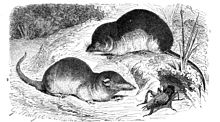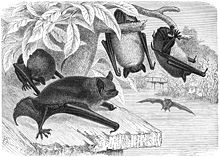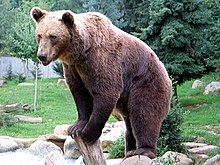List of mammals of Switzerland
 From Wikipedia the free encyclopedia
From Wikipedia the free encyclopedia
This list shows the IUCN Red List status of the mammal species occurring in Switzerland. Nine of them are near threatened, and most are least concern. The following tags are used to highlight each species' status as assessed on the respective Red List published by the International Union for Conservation of Nature:
| EX | Extinct | No reasonable doubt that the last individual has died. |
| EW | Extinct in the wild | Known only to survive in captivity or as a naturalized populations well outside its previous range. |
| CR | Critically endangered | The species is in imminent risk of extinction in the wild. |
| EN | Endangered | The species is facing an extremely high risk of extinction in the wild. |
| VU | Vulnerable | The species is facing a high risk of extinction in the wild. |
| NT | Near threatened | The species does not meet any of the criteria that would categorise it as risking extinction but it is likely to do so in the future. |
| LC | Least concern | There are no current identifiable risks to the species. |
| DD | Data deficient | There is inadequate information to make an assessment of the risks to this species. |



Rodents make up the largest order of mammals, with over 40% of mammalian species. They have two incisors in the upper and lower jaw which grow continually and must be kept short by gnawing.
- Suborder: Castorimorpha
- Family: Castoridae
- Subfamily: Castorinae
- Tribe: Castorini
- Genus: Castor
- Eurasian beaver, C. fiber LC[1] reintroduced
- Genus: Castor
- Tribe: Castorini
- Subfamily: Castorinae
- Family: Castoridae
- Suborder: Sciurognathi
- Family: Sciuridae (squirrels)
- Subfamily: Sciurinae
- Tribe: Sciurini
- Genus: Sciurus
- Red squirrel, S. vulgaris LC[2]
- Genus: Sciurus
- Tribe: Sciurini
- Subfamily: Xerinae
- Tribe: Marmotini
- Genus: Marmota
- Alpine marmot, M. marmota LC
- Genus: Marmota
- Tribe: Marmotini
- Subfamily: Sciurinae
- Family: Gliridae (dormice)
- Subfamily: Leithiinae
- Genus: Dryomys
- Forest dormouse, D. nitedula LC
- Genus: Eliomys
- Garden dormouse, E. quercinus NT[3]
- Genus: Muscardinus
- Hazel dormouse, M. avellanarius LC
- Genus: Dryomys
- Subfamily: Glirinae
- Genus: Glis
- European edible dormouse, G. glis LC
- Genus: Glis
- Subfamily: Leithiinae
- Family: Cricetidae
- Subfamily: Arvicolinae
- Genus: Arvicola
- European water vole, A. amphibius LC[4]
- Genus: Chionomys
- European snow vole, C. nivalis LC
- Genus: Clethrionomys
- Bank vole, C. glareolus LC
- Genus: Microtus
- Field vole, M. agrestis LC
- Common vole, M. arvalis LC
- Alpine pine vole, M. multiplex LC
- European pine vole, M. subterraneus LC
- Genus: Arvicola
- Subfamily: Cricetinae
- Genus: Cricetus
- European hamster, C. cricetus CR[5] extirpated
- Genus: Cricetus
- Subfamily: Arvicolinae
- Family: Muridae (mice, rats, voles, gerbils, hamsters)
- Subfamily: Murinae
- Genus: Mus
- House mouse, M. musculus LC
- Genus: Apodemus
- Alpine field mouse, A. alpicola LC
- Yellow-necked mouse, A. flavicollis LC
- Wood mouse, A. sylvaticus LC
- Genus: Micromys
- Eurasian harvest mouse, M. minutus LC
- Genus: Mus
- Subfamily: Murinae
- Family: Sciuridae (squirrels)
Order: Lagomorpha (lagomorphs)
[edit]
The lagomorphs comprise two families, Leporidae (hares and rabbits), and Ochotonidae (pikas). Though they can resemble rodents, and were classified as a superfamily in that order until the early 20th century, they have since been considered a separate order. They differ from rodents in a number of physical characteristics, such as having four incisors in the upper jaw rather than two.
- Family: Leporidae (rabbits, hares)
- Genus: Lepus
- European hare, L. europaeus LC[6]
- Mountain hare, L. timidus LC[7]
- Genus: Oryctolagus
- European rabbit, O. cuniculus EN introduced[8]
- Genus: Lepus
Order: Eulipotyphla (shrews, hedgehogs and moles)
[edit]




Eulipotyphlans are insectivorous mammals. Shrews and solenodons resemble mice, hedgehogs carry spines, gymnures look more like large rats, while moles are stout-bodied burrowers.
- Family: Erinaceidae (hedgehogs)
- Subfamily: Erinaceinae
- Genus: Erinaceus
- West European hedgehog, E. europaeus LC[9]
- Genus: Erinaceus
- Subfamily: Erinaceinae
- Family: Soricidae (shrews)
- Subfamily: Crocidurinae
- Genus: Crocidura
- Bicolored shrew, C. leucodon LC
- Greater white-toothed shrew, C. russula LC
- Lesser white-toothed shrew, C. suaveolens LC[10]
- Genus: Crocidura
- Subfamily: Soricinae
- Tribe: Nectogalini
- Genus: Neomys
- Mediterranean water shrew, N. anomalus LC
- Eurasian water shrew, N. fodiens LC
- Genus: Neomys
- Tribe: Soricini
- Genus: Sorex
- Alpine shrew, S. alpinus NT
- Common shrew, S. araneus LC
- Crowned shrew, S. coronatus LC
- Eurasian pygmy shrew, S. minutus LC
- Genus: Sorex
- Tribe: Nectogalini
- Subfamily: Crocidurinae
- Family: Talpidae (moles)
- Subfamily: Talpinae
- Tribe: Talpini
- Genus: Talpa
- Mediterranean mole, T. caeca LC
- European mole, T. europaea LC
- Genus: Talpa
- Tribe: Talpini
- Subfamily: Talpinae
Order: Chiroptera (bats)
[edit]


The bats' most distinguishing feature is that their forelimbs are developed as wings, making them the only mammals capable of flight. Bat species account for about 20% of all mammals.
- Family: Vespertilionidae
- Subfamily: Myotinae
- Genus: Myotis
- Bechstein's bat, M. bechsteini NT[11]
- Greater mouse-eared bat, M. myotis LC[12]
- Lesser mouse-eared bat, M. blythii LC[13]
- Brandt's bat, M. brandti LC
- Cryptic myotis, M. crypticus NE
- Daubenton's bat, M. daubentonii LC
- Geoffroy's bat, M. emarginatus LC
- Natterer's bat, M. nattereri LC
- Genus: Myotis
- Subfamily: Vespertilioninae
- Genus: Barbastella
- Barbastelle, B. barbastellus NT
- Genus: Eptesicus
- Northern bat, E. nilssoni LC
- Genus: Nyctalus
- Greater noctule bat, N. lasiopterus NT[14]
- Lesser noctule, N. leisleri LC[15]
- Common noctule, N. noctula LC[16]
- Genus: Pipistrellus
- Nathusius' pipistrelle, P. nathusii LC[17]
- Genus: Plecotus
- Brown long-eared bat, P. auritus LC[18]
- Grey long-eared bat, P. austriacus NT[19]
- Genus: Barbastella
- Subfamily: Miniopterinae
- Genus: Miniopterus
- Common bent-wing bat, M. schreibersii VU[20]
- Genus: Miniopterus
- Subfamily: Myotinae
- Family: Molossidae
- Genus: Tadarida
- European free-tailed bat, T. teniotis LC
- Genus: Tadarida
- Family: Rhinolophidae
- Subfamily: Rhinolophinae
- Genus: Rhinolophus
- Greater horseshoe bat, R. ferrumequinum NT
- Lesser horseshoe bat, R. hipposideros NT
- Genus: Rhinolophus
- Subfamily: Rhinolophinae



There are over 260 species of carnivorans, the majority of which feed primarily on meat. They have a characteristic skull shape and dentition.
- Suborder: Feliformia
- Family: Felidae (cats)
- Subfamily: Felinae
- Genus: Felis
- European wildcat, F. silvestris LC[21]
- Genus: Lynx
- Eurasian lynx, L. lynx LC reintroduced[22]
- Genus: Felis
- Subfamily: Felinae
- Family: Viverridae
- Subfamily: Viverrinae
- Genus: Genetta
- Common genet, G. genetta LC introduced, presence uncertain[23]
- Genus: Genetta
- Subfamily: Viverrinae
- Family: Felidae (cats)
- Suborder: Caniformia
- Family: Canidae
- Genus: Canis
- Gray wolf, C. lupus LC[24]
- Italian wolf, C. l. italicus
- Eurasian wolf, C. l. lupus
- Gray wolf, C. lupus LC[24]
- Genus: Vulpes
- Genus: Canis
- Family: Ursidae (bears)
- Genus: Ursus
- Brown bear, U. arctos LC[26] presence uncertain
- Eurasian brown bear, U. a. arctos presence uncertain
- Brown bear, U. arctos LC[26] presence uncertain
- Genus: Ursus
- Family: Mustelidae (mustelids)
- Genus: Mustela
- Stoat, M. erminea LC[27]
- European mink, M. lutreola CR extirpated[28]
- Least weasel, M. nivalis LC[29]
- European polecat, M. putorius LC[30]
- Genus: Martes
- Beech marten, M. foina LC[31]
- European pine marten, M. martes LC[32]
- Genus: Meles
- European badger, M. meles LC[33]
- Genus: Lutra
- European otter, L. lutra NT[34] reintroduced
- Genus: Mustela
- Family: Canidae
Order: Artiodactyla (even-toed ungulates)
[edit]
The even-toed ungulates are ungulates whose weight is borne about equally by the third and fourth toes, rather than mostly or entirely by the third as in perissodactyls. There are about 220 artiodactyl species, including many that are of great economic importance to humans.
See also
[edit]- List of chordate orders
- Lists of mammals by region
- List of prehistoric mammals
- Mammal classification
- List of mammals described in the 2000s
- Animal production and consumption in Switzerland
References
[edit]- ^ Batbold, J.; Batsaikhan, N.; Shar, S.; Hutterer, R.; Kryštufek, B.; Yigit, N.; Mitsain, G. & Palomo, L. (2016). "Castor fiber". IUCN Red List of Threatened Species. 2016: e.T4007A115067136.
- ^ Amori, G.; Hutterer, R.; Kryštufek, B.; Yigit, N.; Mitsain, G. & Muñoz, L. J. P. (2010). "Sciurus vulgaris". IUCN Red List of Threatened Species. 2010: e.T20025A9136220.
- ^ Bertolino, S.; Amori, G.; Henttonen, H.; Zagorodnyuk, I.; Zima, J.; Juškaitis, R.; Meinig, H. & Kryštufek, B. (2008). "Eliomys quercinus". IUCN Red List of Threatened Species. 2008: e.T7618A12835766.
- ^ Batsaikhan, N.; Henttonen, H.; Meinig, H.; Shenbrot, G.; Bukhnikashvili, A.; Hutterer, R.; Kryštufek, B.; Yigit, N.; Mitsain, G. & Palomo, L. (2016). "Arvicola amphibius". IUCN Red List of Threatened Species. 2016: e.T2149A115060819.
- ^ Banaszek, A.; Bogomolov, P.; Feoktistova, N.; La Haye, M.; Monecke, S.; Reiners, T. E.; Rusin, M.; Surov, A.; Weinhold, U.; Ziomek, J. (2020). "Cricetus cricetus". IUCN Red List of Threatened Species. 2020: e.T5529A111875852. doi:10.2305/IUCN.UK.2020-2.RLTS.T5529A111875852.en. Retrieved 19 November 2021.
- ^ Hacklande, K. & Schai-Braun, S. (2019). "Lepus europaeus". IUCN Red List of Threatened Species. 2019: e.T41280A45187424.
- ^ Smith, A.T. & Johnston, C.H. (2019). "Lepus timidus". IUCN Red List of Threatened Species. 2019: e.T11791A45177198.
- ^ Villafuerte, R. & Delibes-Mateos, M. (2019). "Oryctolagus cuniculus". IUCN Red List of Threatened Species. 2019: e.T41291A45189779.
- ^ Amori, G. (2016). "Erinaceus europaeus". IUCN Red List of Threatened Species. 2016: e.T29650A2791303.
- ^ Hutterer, R.; Amori, G.; Krystufek, B.; Yigit, N.; Mitsain, G. & Palomo, L.J. (2010). "Crocidura suaveolens". IUCN Red List of Threatened Species. 2010: e.T29656A9511068.
- ^ Paunović, M. (2019). "Myotis bechsteinii". IUCN Red List of Threatened Species. 2019: e.T14123A22053752.
- ^ Coroiu, I.; Juste, J. & Paunović, M. (2016). "Myotis myotis". IUCN Red List of Threatened Species. 2016: e.T14133A22051759.
- ^ Juste, J. & Paunović, M. (2016). "Myotis blythii". IUCN Red List of Threatened Species. 2016: e.T14124A22053297.
- ^ Hutson, A. M.; Alcaldé, J. T.; Juste, J.; Karataş, A.; Palmeirim, J. & Paunović, M. (2010). "Nyctalus lasiopterus". IUCN Red List of Threatened Species. 2010: e.T14918A4471682.
- ^ Juste, J. & Paunović, M. (2016). "Nyctalus leisleri". IUCN Red List of Threatened Species. 2016: e.T14919A22016159.
- ^ Csorba, G. & Hutson, A.M. (2016). "Nyctalus noctula". IUCN Red List of Threatened Species. 2016: e.T14920A22015682.
- ^ Hutson, A. M.; Spitzenberger, F.; Juste, J.; Aulagnier, S.; Palmeirim, J.; Karatas, A. & Paunovic, M. (2010). "Pipistrellus nathusii". IUCN Red List of Threatened Species. 2010: e.T17316A6966886.
- ^ Gazaryan, S.; Kruskop, S.V. & Godlevska, L. (2021) [errata version of 2020 assessment]. "Plecotus auritus". IUCN Red List of Threatened Species. 2020: e.T85535522A195861341.
- ^ Gazaryan, S. & Godlevska, L. (2020) [amended version of 2020 assessment]. "Plecotus austriacus". IUCN Red List of Threatened Species. 2020: e.T85533333A195862345.
- ^ Gazaryan, S.; Bücs, S. & Çoraman, E. (2021) [errata version of 2020 assessment]. "Miniopterus schreibersii". IUCN Red List of Threatened Species. 2020: e.T81633057A19585652.
- ^ Gerngross, P.; Ambarli, H.; Angelici, F.M.; Anile, S.; Campbell, R.; Ferreras de Andres, P.; Gil-Sanchez, J.M.; Götz, M.; Jerosch, S.; Mengüllüoglu, D.; Monterosso, P. & Zlatanova, D. (2022). "Felis silvestris". IUCN Red List of Threatened Species. 2022: e.T181049859A181050999. doi:10.2305/IUCN.UK.2022-1.RLTS.T181049859A181050999.en. Retrieved 3 August 2022.
- ^ Breitenmoser, U.; Breitenmoser-Würsten, C.; Lanz, T.; von Arx, M.; Antonevich, A.; Bao, W. & Avgan, B. (2015). "Lynx lynx". IUCN Red List of Threatened Species. 2015: e.T12519A121707666.
- ^ Gaubert, P.; Carvalho, F.; Camps, D. & Do Linh San, E. (2015). "Genetta genetta". IUCN Red List of Threatened Species. 2015: e.T41698A45218636.
- ^ Boitani, L.; Phillips, M. & Jhala, Y. (2018). "Canis lupus". IUCN Red List of Threatened Species. 2018: e.T3746A119623865.
- ^ Hoffmann, M.; Sillero-Zubiri, C. (2016). "Vulpes vulpes". IUCN Red List of Threatened Species. 2016: e.T23062A46190249.
- ^ McLellan, B. N.; Proctor, M. F.; Huber, D. & Michel, S. (2017). "Ursus arctos". IUCN Red List of Threatened Species. 2017: e.T41688A121229971.
- ^ Reid, F.; Helgen, K. & Kranz, A. (2016). "Mustela erminea". IUCN Red List of Threatened Species. 2016: e.T29674A45203335.
- ^ Maran, T.; Aulagnier, S.; Libois, R.; Kranz, A.; Abramov, A. & Wozencraft, C. (2010). "Mustela lutreola". IUCN Red List of Threatened Species. 2010: e.T14018A4381596.
- ^ McDonald, R. A.; Abramov, A. V.; Stubbe, M.; Herrero, J.; Maran, T.; Tikhonov, A.; Cavallini, P.; Kranz, A.; Giannatos, G.; Kryštufek, B. & Reid, F. (2019). "Mustela nivalis". IUCN Red List of Threatened Species. 2019: e.T70207409A147993366.
- ^ Skumatov, D.; Abramov, A.V.; Herrero, J.; Kitchener, A.; Maran, T.; Kranz, A.; Sándor, A.; Stubbe, M.; Saveljev, A.; Savour-Soubelet, A.; Guinot-Ghestem, M.; Zuberogoitia, I.; Birks, J.D.S.; Weber, A.; Melisch, R. & Ruette, S. (2016). "Mustela putorius". IUCN Red List of Threatened Species. 2016: e.T41658A45214384.
- ^ Abramov, A.V.; Kranz, A.; Herrero, J.; Krantz, A.; Choudhury, A. & Maran, T. (2016). "Martes foina". IUCN Red List of Threatened Species. 2016: e.T29672A45202514.
- ^ Herrero, J.; Kranz, A.; Skumatov, D.; Abramov, A.V.; Maran, T. & Monakhov, V.G. (2016). "Martes martes". IUCN Red List of Threatened Species. 2016: e.T12848A45199169.
- ^ Kranz, A.; Abramov, A. V.; Herrero, J. & Maran, T. (2016). "Meles meles". IUCN Red List of Threatened Species. 2016: e.T29673A45203002.
- ^ Roos, A.; Loy, A.; de Silva, P.; Hajkova, P.; Zemanová, B. (2015). "Lutra lutra". IUCN Red List of Threatened Species. 2015: e.T12419A21935287.
- ^ Lydekker, Richard, ed. (1904). Library of Natural History. Saalfield Publishing Company.
- ^ Toïgo, C.; Brambilla, A.; Grignolio, S. & Pedrotti, L. (2020). "Capra ibex". IUCN Red List of Threatened Species. 2020: e.T42397A161916377.
- ^ Aulagnier, S.; Giannatos, G. & Herrero, J. (2008). "Rupicapra rupicapra". IUCN Red List of Threatened Species. 2008: e.T39255A10179647.
- ^ Lovari, S.; Lorenzini, R.; Masseti, M.; Pereladova, O.; Carden, R.F.; Brook, S.M. & Mattioli, S. (2018). "Cervus elaphus". IUCN Red List of Threatened Species. 2018: e.T55997072A142404453.
- ^ Masseti, M.; Mertzanidou, D. (2008). "Dama dama". IUCN Red List of Threatened Species. 2008: e.T42188A10656554. doi:10.2305/IUCN.UK.2008.RLTS.T42188A10656554.en. Retrieved 19 November 2021.
- ^ Lovari, S.; Herrero, J.; Masseti, M.; Ambarli, H.; Lorenzini, R. & Giannatos, G. (2016). "Capreolus capreolus". IUCN Red List of Threatened Species. 2016: e.T42395A22161386.
- ^ Keuling, O. & Leus, K. (2019). "Sus scrofa". IUCN Red List of Threatened Species. 2019: e.T41775A44141833.
External links
[edit]- "Animal Diversity Web". University of Michigan Museum of Zoology. 1995–2006. Retrieved 6 August 2012.